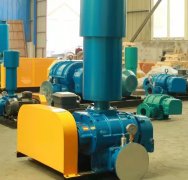In depth exploration: Key differences between rotary fans and Roots fans
The following is a detailed introduction to rotary fans and Roots fans:
1、 Rotary fan
1. Definition: Rotary fan is a device used for blowing air, characterized by the eccentric rotation of the rotor in the cylinder body and the use of oil lubrication.
2. Wind volume and pressure range: The wind volume range is usually 0.31 cubic meters to 5.41 cubic meters per minute, while the pressure range is 9.8 kilopascals to 49 kilopascals. This type of fan belongs to the category of small blowers and medium pressure fans.
3. Main purpose:
Water treatment blast aeration
Hospital sewage mixing and aeration
Vacuum paper feeding in the printing industry
Mixing and aeration of domestic sewage and industrial wastewater
Gas supply for plastic welding and blowing
Burner spray, glass industry, etc
4. Main features:
① Small size, high air volume, low noise, and low energy consumption.
② Smooth operation and easy installation.
③ Resistance to load changes and stable airflow.
④ Equipped with an air chamber for smooth air dispersion.
5. Component composition: The rotary fan consists of a main engine, a base, a motor, large and small pulleys, an air chamber, an air filter, a drip nozzle, and other components. The main body is made of cast iron, including key components such as metal rings, rotors, slides, eccentric cylinder bodies, and pump covers.
2、 Roots blower
1. Definition: Roots blower is a type of positive displacement fan that works by using two blade rotors to compress and transport gas through relative motion within a cylinder.
2. Air volume and pressure range: The air volume range is 0.6 cubic meters to 824.6 cubic meters per minute, and the pressure range is 9.8 kilopascals to 196 kilopascals.
3. Application scope: Roots blowers are widely used in aquaculture oxygenation, sewage treatment aeration, cement transportation and other fields. They are also suitable for gas transportation and pressurization systems in low-pressure environments, and can be used as vacuum pumps.
4. Main features:
① The structure is simple and easy to manufacture.
② Low vibration and noise.
③ The impeller and shaft are an integral structure, with no wear and tear, and the performance of the fan remains unchanged for a long time.
④ It can operate continuously for a long time and has high volumetric efficiency.
5. Component composition: The Roots blower consists of five main parts: the casing, wall panels, impeller, oil tank, and muffler. Among them, the casing plays a supporting and fixing role, the wall panel connects the casing with the impeller and supports the rotation of the impeller. The impeller is the rotating part of the Roots blower, the oil tank is used to store lubricating oil, and the muffler is used to reduce noise.
Classification: Roots blowers can be classified according to various methods such as working mode, number of impeller heads, purpose, medium type, transmission mode, cooling mode, structural type, and sealing type.
In summary, there are significant differences between rotary fans and Roots fans in terms of definition, air volume and pressure range, application scope, main characteristics, and component composition. In practical applications, it is necessary to choose the appropriate type of fan according to specific needs.





